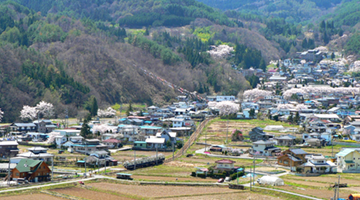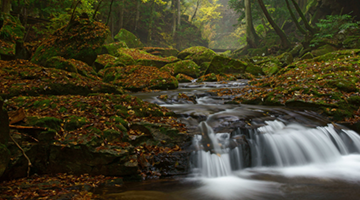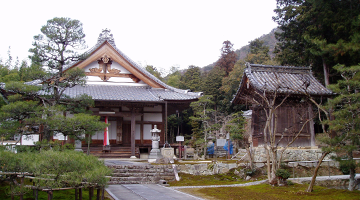Heisenji Hakusan Shrine


Recommended Themes, Seasons and Activities


Natural Scenery:Mountain and Valley, Pond and Lake, Flower and Tree, Stone and Rock
History:Shrines and Temples、Garden
Good Luck and Festivals:Spiritual Sites
The Arts:Sculpture

Spring / Summer / Autumn / Winter

Cultural Experiences(Market) / Walk / Photograph
A sacred place, where the pilgrimage route to Mount Hakusan begins
Mount Hakusan has been the object of worship since ancient times, both as a guardian deity of the people and a god of water. Ascetic monks would climb the mountain as a pilgrimage, and even laypeople came to Mount Hakusan to worship. There are three routes to the summit of Mount Hakusan, one from each of the three feudal domains of Echizen, Kaga, and Mino. It is said that Hakusan Heisenji temple was established at the beginning of the 8th century by the monk Taicho to serve as the base point for the Echizen route. The pilgrimage route to Mount Hakusan, called the Echizen Zenjodo, starts from the Sannomiya Shrine in the most secluded part of the grounds. One of the 100 Historical Roads of Japan, the route leads through a grove of cedars, then follows a ridgeline into the interior of the forest.
At the height of its glory, Heisenji was home to 8,000 monks, making it the largest religious settlement in Japan at the time. However, in the latter half of the 16th century, the entire temple was attacked and burned to the ground during the Echizen uprising. Since then, it has been partially restored and has passed quietly through the ages up to the present. In recent years, the remains of many stone-paved roads, stone walls, and monks’ residences have been discovered, painting a clear picture of the magnificent way of life that was once led within the precincts.
Waterfalls, springs, and rocks: A tour of the sights within the grounds
Mount Hakusan has three peaks called Gozengamine, Onanjimine, and Betsusan, on all of which Hakusan Heisenji has shrines where the respective deities are enshrined, with the Gozengamine Shrine being the main one. The Gozengamine Shrine enshrines the deity of Gozengamine, the highest peak on Mount Hakusan, and presents visitors with the marvelous sight of ascending and descending dragons supporting the shrine’s eaves.
The old entrance path into the temple precincts is flanked by rows of cedar trees collectively known as the Bodairin (Forest of Enlightenment). It is said that the paving stones were carried there from the banks of the Kuzuryu River by ascetic monks about 1,000 years ago, and the sense of history is palpable. There is also a spring they say was discovered by Taicho on his way up Mount Hakusan. It is said that Taicho established Heisenji in association with the spring based on a revelation from a goddess who appeared to him there. The grounds of Heisenji are filled with a variety of spots whose origins are shrouded in legend. One such spot is the Musubi Shrine. Two large stones are enshrined there that are said to have descended from heaven at the same time. Ever since, the shrine’s deity has been known as the god of wedlock.
Heisenji Hakusan Shrine
Address |
Heisenji, Heisenji-cho Katsuyama, Fukui Prefecture |
Hours |
Visitors can freely enter the shrine precincts |
Closed |
Open daily |
Cost |
Free of charge
Visitors are charged 50 yen to enter (reservations required) Kyugensei-in Teien (National Site of Scenic Beauty) |
Phone |
Heisenji Hakusan Jinja Office 0779-88-1591
Katsuyama City Sightseeing Policy Division 0779-88-81177 |
Access |
By car from Echizen Railway Katsuyama Sta., about 10 min
By Katsuyama-shi Community Bus from Echizen Railway Katsuyama Sta. to Heisenji Jinja-mae, about 30 min (Community Bus operates only on Sundays and holidays and is unavailable during winter period.) |
Web site |
http://heisenji.jp/ |
Other Spots

-

Zuiryuji Temple

Toyama

History
Good Luck and Festivals
Spring
Autumn
-

Zuisenji Temple

Toyama

History
Good Luck and Festivals
The Arts
Spring
Summer
Autumn
Winter
-

Shirayama Hime Jinja Shrine

Ishikawa

Natural Scenery
History
Good Luck and Festivals
The Arts
Spring
Summer
Autumn
Winter
-

Sojiji Soin

Ishikawa

History
Good Luck and Festivals
Spring
Summer
Autumn
Winter
-

The Ukimido Pavilion

Ishikawa

Natural Scenery
Dragon Legends
Spring
Summer
Autumn
-

Kenrokuen Garden

Ishikawa

Natural Scenery
History
Good Luck and Festivals
Spring
Summer
Autumn
Winter
-

Keya Kurotatsu Jinja Shrine

Fukui

Natural Scenery
History
Good Luck and Festivals
The Arts
Spring
Summer
Autumn
-

Hakusan Heisenji Shrine

Fukui

Natural Scenery
History
Good Luck and Festivals
The Arts
Spring
Summer
Autumn
-

Tenryukyo

Nagano

Natural Scenery
Spring
Summer
Autumn
Winter
-

Togakushi Jinja Shrine

Nagano

Dragon Legends
History
Good Luck and Festivals
The Arts
Spring
Summer
Autumn
Winter
-

Bessho Onsen

Nagano

Dragon Legends
History
Good Luck and Festivals
Spring
Summer
Autumn
Winter
-

Myokenji Temple

Nagano

History
The Arts
Spring
Summer
Autumn
Winter
-

Kokeizan Eiho-ji Temple

Gifu

Natural Scenery
History
Good Luck and Festivals
Spring
Summer
Autumn
Winter
-

Gifu Castle on Mount Kinkazan

Gifu

Natural Scenery
History
Spring
Summer
Autumn
Winter
-

Ryujin-no-Taki Falls

Gifu

Natural Scenery
Dragon Legends
History
Good Luck and Festivals
Spring
Summer
Autumn
-

Headwaters of the Nagaragawa River

Gifu

Natural Scenery
Dragon Legends
Spring
Summer
Autumn
Winter
-

Senkoji Temple

Gifu

Natural Scenery
History
Good Luck and Festivals
The Arts
Spring
Summer
Autumn
-

Mount Ryusozan

Shizuoka

Natural Scenery
History
Spring
Summer
Autumn
-

Hokoji Temple

Shizuoka

Natural Scenery
Dragon Legends
History
The Arts
Spring
Summer
Autumn
Winter
-

Atsuta Jingu Shrine

Aichi

Natural Scenery
History
Good Luck and Festivals
The Arts
Spring
Summer
Autumn
Winter
-

Tatsuki Jinja Shrine

Aichi

Dragon Legends
History
Good Luck and Festivals
The Arts
Spring
Summer
Autumn
Winter
-

Masumida Jinja Shrine

Aichi

Dragon Legends
History
Good Luck and Festivals
Spring
Summer
Autumn
Winter
-

The akame 48 falls

Mie

Natural Scenery
Dragon Legends
Spring
Summer
Autumn
Winter
-

Yokoyama Ishigami Jinja Shrine

Mie

Dragon Legends
History
Good Luck and Festivals
Spring
Summer
Autumn
Winter
-

Yahashira Jinja Shrine

Mie

History
Good Luck and Festivals
Spring
Summer
Autumn
Winter
-

Chikubushima Island Hogonji Temple

Shiga

Natural Scenery
Dragon Legends
History
Good Luck and Festivals
Spring
Summer
Autumn
Winter
-

Ryuoji Temple

Shiga

Dragon Legends
History
Good Luck and Festivals
Spring
Summer
Autumn
Winter
-

Ryuogu at ruins of Unkanji Temple

Shiga

Natural Scenery
Dragon Legends
History
Spring
Summer
Autumn
-

Garyu-no-Mori Forest

Shiga

Natural Scenery
Spring
Summer
Autumn
Winter
-

Eigenji Temple Founder’s Hall

Shiga

Natural Scenery
History
Good Luck and Festivals
Spring
Summer
Autumn
Winter

See Other Routes

The Four Shoryudo Routes
























































































